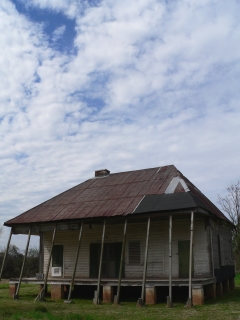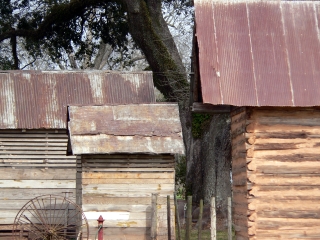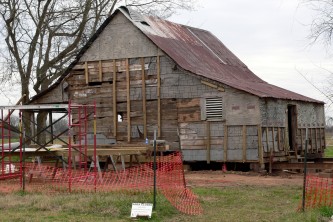NPS Website; Local Website; NPS Cane River NHA Website; Local Cane River NHA Website
 WHAT IS IT?
WHAT IS IT?Original buildings and land of two large cotton Plantations, Oakland and Magnolia, situated along the Cane River in rural Louisiana. Eight of Magnolia’s brick outbuildings are restored. Several wooden structures, including the main house at Oakland are being made structurally sound and renovated to represent various eras of the working plantation.
BEAUTY (3/10)
Oakland and Magnolia suffer from years of neglect. The Park Service is hard at work repairing the properties and opening as many buildings as possible to the public. However, most of Magnolia remains behind an uninviting fence open by pre-arranged appointment only. Oakland resembles a construction site more so than a National Park. In a few years, these places may be as grand as any Natchez home, but there is still a lot of work to do.
HISTORICAL INTEREST (5/10)
Oakland remained in the hands of the same family from its acquisition as a land grant in 1821 to its integration into the Park Service in 1994. The Plantation documents the transition from a slave-driven cotton economy to the creation of self-sufficient communities shaped by owners and sharecroppers to the eventual decline of the plantation system.
Magnolia Plantation was, at one time, the most extensive and profitable plantation in central Louisiana spreading over 7,500 acres with no less than 275 enslaved laborers.
The Cane River Creole NHP attempts to tell several stories here: the rise and fall of the plantation system, the personal histories of those who owned and worked the land and the emergence of the Creole culture. Since the NHP is still a work in progress, it is hard to say which of these histories will take precedence.
CROWDS (4/10)
Visitors: 4. Builders, construction and maintenance workers: at least a dozen.
We were never sure where we were allowed to walk and which parts of the Site were off limits, so we just tried to stay out of everyone’s way. Perhaps if there were a steadier stream of visitors, the Site would make accommodating them more of a priority.
We felt like we had arrived at a party too soon and caught the hostess in her bathrobe, completely unprepared for her guests.
 EASE OF USE/ACCESS (2/5)
EASE OF USE/ACCESS (2/5)Both Oakland and Magnolia are located just off Interstate 49 near Natchitoches, (inexplicably pronounced NACK-uh-tish) Louisiana. At present, the Site’s proximity to the Interstate does not help accessibility. There are no signs on the Interstate telling you which exit to take, but both plantations are on Louisiana Route 119.
At Oakland, there are no tours and no Rangers on duty until 1:00pm. We arrived at 11:00am, as did another couple, because the NPS book said there would be a tour at that time. No dice. The bookstore was also closed and set to open at 1. We walked around aimlessly with a self-guided mimeograph hoping to track down a Ranger to answer some questions.
CONCESSIONS/BOOKSTORE (3/5)
The bookstore is located in the building that once housed the Plantation’s store and post office. There are not many books for sale but many go into great depth about both the Site and local history. While we browsed, a Ranger entered the store to verify information using two of the books for sale.
COSTS (4/5)
The Site is free. There is a free Ranger-led tour of Oakland given at 1:00pm. The National Parks Book says there are also tours at 9, 11 and 3. The book is wrong. These tours do not exist. Don’t be disappointed.
RANGER/GUIDE TO TOURIST RATIO (3/5)
There appears to be a Ranger residence on site. We met one Ranger in the bookstore consulting with a foreman. Another Ranger actively avoided us even though it was clear we were wandering aimlessly looking for guidance.
TOURS/CLASSES (5/10)
Visitors are welcome to tour the grounds of the Oakland plantation from 8:00am to 4:00pm any day of the week. A Ranger tour, staff permitting, begins at 1:00 pm. Good luck finding assistance before then.
We must have been a sorrowful sight. After the first Ranger pretended not to see us, a very tall man approached us and asked if there was anything he could do for us. He unlocked the Bookstore and let us browse and answered a good deal of the questions that had been piling up all morning. He introduced himself as a direct descendant of the Prudhomme family, the former owners of Oakland. So we picked his brain a little more.
Why did the park service have an interest in this plantation? Why work so hard to restore it? Why are the buildings being renovated to different time periods? We can’t say that all of his answers were satisfactory; his point of view was obviously a biased one. He praised NPS for involving the Prudhomme family in the process and expressed appreciation for the new knowledge he had for his heritage. Great for him, but we still question the historical significance of the Site.
We did not stay for the 1pm tour.
Our visit to Cane River Creole NHP was a reminder to us to do our homework. A call to the Site would have clarified the time of the one available tour and a visit to the website would have given us some clues as to the present state of the Site. Lessons learned.
FUN (4/10)
We have to thank the member of the Prudhomme family for salvaging what was becoming a disappointing morning. He went out of his way to share what he knew about Oakland and offered a unique perspective – one of someone who had played in the Main House as a child and remembered Oakland not as a historical site, but as a place to meet his cousins and run through the yard.
As a member of the team repairing the structures, he was able to explain the processes and reasoning behind some of the renovation. Why was the Main House being restored to its 1960s appearance when it was built in 1821? Economics, really. It would be cost prohibitive to remove all of the additions and modernizations, like indoor plumbing and electricity from the home. What’s bousillage? Now we know: it’s a filler made from local dirt mixed with Spanish moss used heavily in many of Oakland’s outbuildings, making restoration all the more difficult.
Our unsuspecting host was gracious and never made us feel like we were a bother, even though we took at least an hour of his time. “You’re here to see Oakland and without visitors, what’s the point?”
 WOULD WE RECOMMEND? (3/10)
WOULD WE RECOMMEND? (3/10)The Cane River Creole NHP is not a typical tourist destination. In fact, we doubt that most people in nearby Natchitoches know it exists. Even though Oakland and Magnolia Plantations are featured sites in the Cane River National Heritage Area, the local municipality has granted them only two roadside signs to direct visitors to the grounds. NPS is currently deciding the most effective placement of their allotted signs.
The Site’s website asks visitors to pardon their dust and assures readers that watching the progress of the preservation of the plantation is part of the attraction. We disagree. Paths to the Site are circuitous and require a time commitment. Wait until park services are more established and more of the Site is ready for the party before you make the journey.
TOTAL 36/80
www.usa-c2c.com
© 2004-06